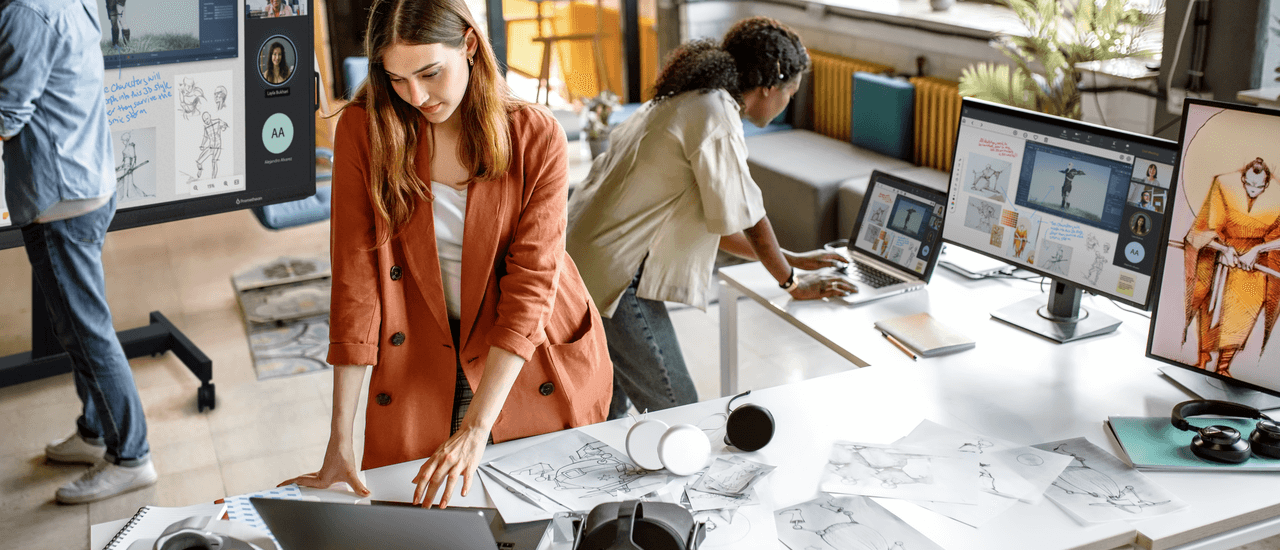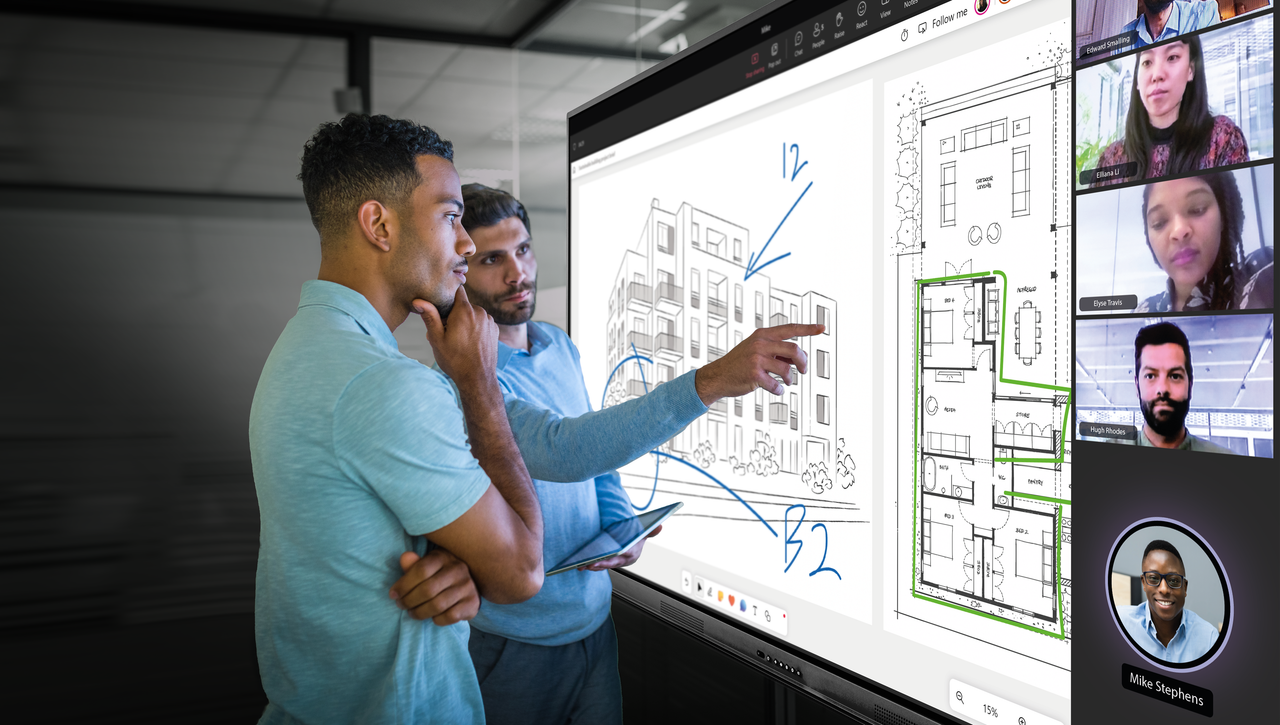Published on November 11th, 2024
What are collaborative workspaces, and how can you create them?
16 minute read

Summary
For many people, the days of cloistering away in a small cubicle by yourself are long gone. In the past 20 years, workplace collaboration has increased by 50%, and employee turnover dropped by half due to effective communication and collaboration. Keep in mind that we are talking about collaboration, not teamwork. So, how is collaboration different from teamwork?
The main difference has to do with expertise. Teamwork occurs when individuals join forces when they have shared goals or circumstances, whereas collaboration involves selecting individuals based on their skill sets to achieve a well-defined objective. In collaborative workspaces, this distinction is crucial for maximizing efficiency and success.
To have experts all collaborating in the workflow of your company, you need the right kind of workspace, but what that collaborative workspace looks like has a lot of variations.
Defining a collaborative workspace
When you hear ‘collaborative workspace’ you might think of those pictures we’ve seen online of tech giant offices where employees mill around playing foosball and indoor miniature golf before taking a half-hour break in the nap room. While those are examples of collaborative workspaces, they usually aren’t quite so elaborate.
Technically, a collaborative workspace is any space in an office building where a group can show up and start working together. However, some spaces work a lot better than others. Sure, you could bring all your laptops into the break room and huddle around a small card table next to the mini fridge, but will that facilitate the best work meeting? A well-designed collaborative workspace gives workers the tools they need to access information, communicate with each other effectively, and be comfortable and focused while doing it.
With 70% of employees thinking that poor collaboration negatively affects productivity, it’s clear that most industries value working together. Collaborative workspaces open up an entirely new way to run an office, but they aren’t perfect for every situation. Depending on the disposition of your workers and the industry you’re working in, the amount of collaborative workspace you need can vary a lot. Before we get into the details of building an effective collaborative workspace, we need to consider some of the major advantages and drawbacks.
The pros and cons of collaborative workspaces
On the positive side, collaborative office spaces can increase productivity by improving communication. If you’re sitting next to the person you need to talk to it’s a lot easier to talk to them than send them an email. Collaborative workspaces can also enhance inclusivity and improve employee satisfaction by building stronger connections between team members and letting them bounce ideas off one another. As a result, they can play an important role in advancing a company’s ESG (Environmental, Social, and Governance) initiatives. While especially beneficial for creative industries, collaborative workspaces are valuable in any setting that requires complex problem-solving.
However, collaborative workspaces have some drawbacks as well. Noise and distractions can be a pain for employees trying to concentrate on their work, and a lack of privacy can be a major issue as well. This is particularly problematic in industries where privacy is a major concern, such as healthcare or finance. The key to building a successful collaborative workspace is making sure your task fits the space. A good collaborative workspace is there when it’s needed and equipped with a suite of team collaboration tools ready to go.
Team collaboration tools
Providing a meeting room with just a table and chairs won’t get your team to where they need to be. Building a successful collaborative office space means giving your workers the tools they need to get the job done. Considerations like budget, scalability, compatibility, and maintenance all contribute to finding the best solution for your workplace. To break it down a bit more, let’s look at collaboration software and hardware.
Software
As far as software, there are a few options to explore to make collaboration as seamless as possible. You may want to explore project management tools to let your teams organize, schedule, and track projects digitally, while communication platforms can allow them to keep lines of consistent information flowing through live chats and messages. Similarly, document collaboration tools will let your team share data easily and work together on deliverables.
Explain Everything Advanced is a great option for those looking for a cloud based solution that allows for whiteboarding, polling, and recording.
Hardware
Yes, we are talking about computers, monitors, and laptops – but hardware for a collaborative workspace goes beyond the basics. For instance, you’ll need high-quality audio and video equipment for video conferencing and headphones or headsets to minimize noise distractions if you have multiple conversations going on at once. Another essential is an interactive display that helps with brainstorming ideas, note-taking, and presentations. Interactive displays also allow you to project video conference calls for the entire room and display presentation slides with other content on large screens.
To get your collaborative workspace up and running, you’ve got to make sure all these pieces of hardware can talk to each other. Adopting a cohesive suite of software tools tailored to work with particular hardware can save you a massive headache when you’re trying to set up a collaborative work session. For example, Promethean’s interactive displays can be paired with an OPS of your choice to allow for seamless integration of your preferred working environment. If you choose an OPS-M you can utilize the Microsoft Whiteboard and Teams which allows employees to collaborate in any scenario–in person, or with remote team members.
Moreover, Promethean offers applications on the ActivPanel that enhance employee collaboration like ScreenShare, Annotate, or Timer.
Building your collaborative workspace
There isn’t a one-size-fits-all solution for building collaborative workspaces. A lot of it depends on your company’s culture, values, and the type of industry you’re in. That said, there are a few considerations that apply to most situations. Consider involving employees in the design process as they may have feedback on what will work well for your organization. This also provides a sense of ownership of the space. Always remember to provide clear guidelines and expectations on how to use the space.
One of the biggest considerations is how much space you are working with. Office space comes in all shapes and sizes, from large open floor plans to a hallway full of broom closet-sized rooms. While the varieties are almost endless, let’s take a look at a few options and considerations involved in building a collaborative workspace in varying settings.
Open floor plans
Although the quintessential office space is traditionally filled with row upon row of cubicles, the norms are changing in office practices. Today, it’s not uncommon to have a completely open floor plan with no barriers between desks or workspaces. However, tearing down cubicle walls won’t necessarily make it a good collaborative workspace.
First, acoustics is a major issue. If you want dozens of people talking with each other at once in a large area, the last thing you need is concrete floors and walls making it a deafening echo chamber. Carpet, sound-reducing wall coverings, and plush furniture go a long way in making conversations hearable in an environment like this.
Workplace technology is a big help in these kinds of large open spaces. Mobile interactive displays work well in environments like this because you can wheel them out when you need to address groups but then tuck them away so they are not a distraction during normal workflow.
Another strategy for large workspaces is to not assign desks to particular employees – a practice known as hot-desking, which can build a stronger sense of shared ownership but depends a lot on the preference of your workers.
Mid-sized meeting rooms
Nearly every office building has these, but there are steps you can take to make them impactful shared spaces instead of bland meeting rooms. Although it’s not your employee’s permanent office space, meeting rooms, and breakout areas are a great solution for project collaboration. Just be sure to implement a clear scheduling system so employees have access to the space when they need it.
Ergonomic furniture is important for employee comfort and productivity, and incorporating technology is a huge factor in giving workers what they need to succeed. The furniture layout itself can also have an impact. Setting up desks and chairs facing away from each other in corners leads to better focus and concentration for individuals but less collaboration, whereas couches and chairs organized facing one another promote an exchange of ideas.
Flexibility is key in making a shared work area functional. Modular designs let workers move furniture and tools around as they need, and versatile technological integration helps make the space work for almost any purpose.
Meeting rooms also make it possible to have an effective collaborative workspace online. Equipping the space with audio-visual technology to allow for video conferencing means that you can pull from the skill sets of employees around the world as well as those on-site when tackling a problem.
Small office spaces
If your company is working well, collaboration will happen anywhere – including small offices meant for only a few occupants. Generally speaking, an office is going to belong to a particular employee, but there are a lot of things they can do to make it welcoming and conducive to great collaboration.
It’s important to maximize space and look for multifunctional furniture like convertible tables and storage units with built-in seating. Consider setting aside a small space with a few chairs specifically for collaboration. Include a place to take notes and technology that helps you explain or record valuable information.
When deciding on office spaces to use for collaboration, one of the biggest factors is the workflow of the office owner. In a lot of cases, it’s better to see where employees start congregating to discuss ideas and then start adding collaborative equipment to that space. In a healthy workplace, it will happen – you just need to keep an eye out, and as soon as you notice a trend, start improving the space to make that collaboration take off.
Future trends in collaborative workspaces
The 2020s brought a huge shift in workplace practices. Despite the recent push to bring workers back to the office in person, remote and hybrid work let companies see the possibilities of collaboration at a distance. Many businesses have moved to a global workforce. Virtual collaboration tools like video conferencing and online meeting platforms let remote workers and on-site workers share ideas and inspiration.
As for what the future holds, smart technology will likely impact workspaces and allow high levels of customization to meet the needs of employees. AI assistance can implement scheduling for meeting facilities, while workplace analytics can track employee behavior and satisfaction. As technology becomes more user-friendly, employees can jump right into making engaging presentations or sharing ideas without a steep learning curve.
Greater collaboration will also have a big impact on learning and development. When employees share knowledge, they can learn from one another, which in turn provides opportunities for training and development. For example, if a new hire closely collaborates with a veteran of twenty years, the new hire is going to learn a lot simply in the process of working on a project. If you can provide the kind of collaborative workspaces we’ve talked about, you can use those spaces for guest speaker series, mentorship programs, lunch and learn sessions, or professional development workshops.
Whether you are working with a large office complex or just a few small rooms, there’s a lot you can do to make your space a place where people can come together, share ideas, and solve problems.
Check out Promethean’s free demo to start building a collaborative workspace today.
Further reading:




